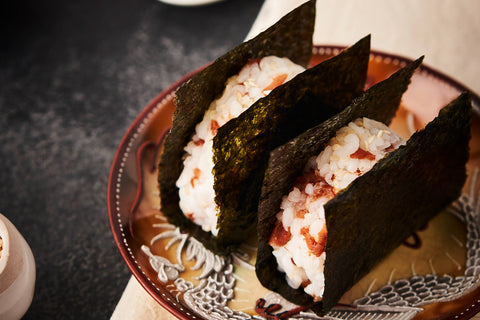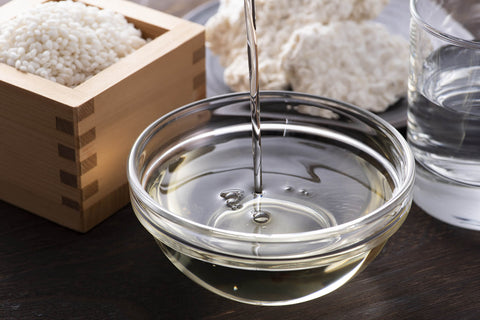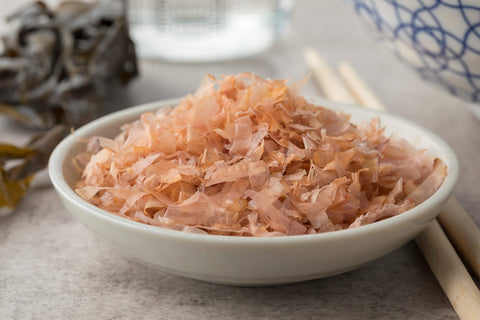
Nori is the name given to an edible seaweed (specifically a form of red algae) frequently used in Japanese cuisine in its dried form. It is perhaps most commonly used in the preparation of sushi rolls and onigiri, where it used for tightly wrapping the sushi rice and other ingredients.
History
While the word nori today describes dried seaweed sold in thin sheets, it was originally a generic term for all kinds of marine plant-life. There is evidence of seaweed harvesting from as far back as 701, when it was mentioned in the Taihō Code as a taxable commodity. Local reports to the reigning monarch (fudoki) dating to the early 8th century show that the drying of nori for consumption was taking place in the Hitachi and Izumo Provinces at this time, and likely elsewhere. Japan’s oldest long-form narrative, Utsubo Monogatari (Tale of the Hollow Tree), published in the late 10th century also mentions nori harvesting and drying, showing that it was a commonplace food by that time.
What we know of nori at this time suggests that it was dried out and eaten in a paste form. The sheet-like nori that we recognise today was invented around 1750 in Asakusa, Edo, using a similar method as that employed in Japanese paper making.
Production
Red algae, of the genus Pyropia, is an abundant marine crop in East Asia, particularly in Japan where seaweed farms can be found right along the coast. These seaweed plantations comprise of a series of nets suspended below the surface of the ocean, onto which the Pyropia seeds are planted. The algae grows quickly, reaching maturity in around 45 days after first being seeded.
This fresh nori is harvested by farmers using boats to reach the seaweed nets. They do not recover the whole plant in one go. By restricting themselves to the outer layers of nori, the nets can be returned to the sea, where they will produce a fresh harvest in around ten days’ time. These days, much of the harvesting work is performed using specially-constructed machinery for the task.
Traditionally, this raw material is shredded and pulped, before being pressed into thin sheets. This pressing releases most of the water from the nori, which is then placed in a rack for drying. The drying process can take anything from a few hours to several days, depending on the temperature of the drying room and the thickness of the nori sheets. Modern production methods automate a lot of this process, including heat-drying the nori sheets in a matter of minutes.
Storage
Nori sheets are highly absorbent, which is why they are a popular addition to soups, stews, and stocks. However, they can also absorb moisture from the air itself, which causes them to quickly degrade. To prevent this from happening, dried nori should be stored with some sort of desiccant to keep it dry.
Grading
There are eight annual harvests in the nori season. The first occurs when the waters are at their coolest and is considered the best by nori farmers. The last harvest produces nori of the lowest quality.
Nori grading is a complex process, more so than the simple three-point grading system on most commercial packaging would imply. These packaging grades are added by the buyer for the benefit of their customers, while the grading system utilised by nori farmers is much more complex, including the following factors among many others:
Harvest number: ranking from 1 to 8, with 1 being the highest quality.
Colour: the best nori is a deep green with an almost metallic sheen. Pale green and almost black nori is less desirable.
Amount of holes: The fewer holes in a sheet of nori, the better.
Density: Nori density is determined by holding a sheet up to the light. The density should be consistent across the entire sheet.
Dead nori: If the nori sheet has white spots on the surface, this indicates that it is dead. Consequently, high-quality nori will have fewer white spots.
Farm location: The best nori comes from the south of Japan, from the Ariake sea. While nori can be farmed outside of Japan, Japanese nori is highly-prized as the most flavourful and of the highest quality. This is why all SushiSushi nori is grown and harvested in Japan.
Nori in Japanese Cuisine
The most popular use for nori in Japanese cuisine is as a wrap for onigiri and sushi rolls. Rice and other fillings are placed carefully on a sheet of nori, with the whole then rolled up tightly using a bamboo mat (makisu). It takes skill and practice to get the technique just right, but it is well worth the effort to do so.
Nori is also added to soups and noodle broth, either as a garnish or to add flavour.
Nori can be eaten on its own, though it is typically toasted before doing so. Some people like to flavour their nori during the toasting process, often using soy sauce, sake, mirin, sugar, and seasoning to create ajitsuke-nori.
Nori can also be combined with soy sauce to produce a rich, black, flavourful paste known as nori no tsukudani, which is a popular accompaniment for steamed rice.
Nori is often added as a garnish to classic ramen noodles or can be shredded and used as a topping for yakisoba
Taste
Quality nori has a taste of the sea – not a fishy taste, but closer to taking a deep breath at the ocean’s edge. The taste of fresh sea air is the characteristic flavour of quality nori and will be familiar to anybody who has enjoyed it wrapped around a sushi roll. It is a delicate flavour, one that is pleasantly complemented by the sushi rice, but also easily overpowered by other condiments such as soy sauce and wasabi. In its toasted form as yaki-nori, its flavours become more prominent, but are often mixed in with other seasoning to create an altogether different taste sensation.
Nutritional Benefits
Nori is well regarded a healthy foodstuff. It is high in Vitamin A, Vitamin B2, and Vitamin C, as well as being a good source of potassium and iron.
Popular Products
These are just some of the nori products and variations that prove particularly popular at SushiSushi. Click on a link to learn more, or visit our online store for more nori products.
Yamagataya Japanese Grown Nori
This is the best-tasting nori you will ever lay hands on, direct from our suppliers in Japan. The pre-cut sheets are perfect for making tamaki sushi (hand rolls) or eating on its own, as a delicious snack.
Yamagataya Roasted Snack Nori
Speaking of delicious snacks, these roasted nori sheets are ideal for picking at when you want a something tasty, yet nutritious to nibble at. Glazed with a slightly sweet soy sauce, blended with kombu, bonito dashi, and koji, they offer a unique taste sensation.
Momoya Nori Seaweed Jam
This delicious seaweed jam is made up of nori that has been boiled with soy sauce, mirin, and sugar. It results in a salty-sweet flavour that is traditionally served with plain rice, but also works well stirred into pasta as a sauce.
Our Suppliers
Here at SushiSushi, we source our nori from some of the most well-respected and established producers in Japan. These include:
Yamagataya
The first Yamagataya Nori store was established in 1764 by Sohachi Kubota. For more than 250 years, the firm has grown, harvested, and processed some of the finest nori products on the market. A firm favourite with restaurant chefs and home cooks alike, Yamagataya nori supply us with some of our most popular products.
Daihoku
Founded in 1974, Daihoku produces a range of seaweed products developed using ingredients from their local Hokkaido environment. Their focus is the creation of a brand synonymous with modern Japanese cooking. They produce delicious roasted nori, dried seaweed, and other processed agricultural products with a distinctive flavour.
Momoya
Momoya, was founded in 1920 and is well-regarded for the quality of their ingredients and their specialised methods of production. Combining the latest machinery and technology with manual processes, they take their time to produce delicious nori and other products, much in demand among our customers.















